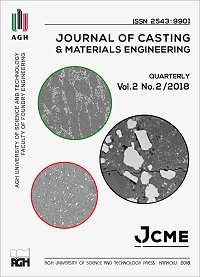Effect of Solution Treatment on the Age-Hardening Behavior of Al-12Si-1Mg-1Cu Piston Alloy with Trace-Zr Addition
DOI:
https://doi.org/10.7494/jcme.2018.2.2.30Abstract
The influence of a solution treatment with a trace zirconium addition on the precipitation behavior of a cast Al-12%Si-1%Mg-1%Cu piston alloy has been reported. The alloys were prepared by controlled melting and casting. The cast alloys were given an age-hardening treatment having a sequence of homogenization, T6 solutionizing, quenching, and aging. Both the cast and solutionized samples were naturally aged for 58 days, isochronally aged for 60 minutes at different temperatures (up to 350°C), and isothermally aged at various temperatures (up to 225°C) for different periods of time (ranging from 15 to 360 minutes). The hardness values of the differently processed alloys were measured to understand the aging behavior of the alloys. Electrical resistivity changes with aging time and temperature were measured to understand the precipitation behavior of the alloys. It is observed that significant hardening takes place in the aged alloys due to the formation of GP zones as well as the formation of metastable phases. The solutionizing treatment improves the hardness because some alloying elements are re-dissolved during solution treatment to produce a solute-rich solid solution. The trace-added Zr hinders the softening due to the precipitation of Al3Zr, which is very stable against coarsening and the re-dissolution of precipitates. Electrical resistivity decreases due to stress relieving, the dissolution of the metastable phase, and precipitation coarsening. The resistivity of the solutionized alloys decreases more due to the higher concentration of elements in the solid solution. A microstructural study of the alloys reveals that the solution treatment improves the distribution of the silicon grains. It is also observed that the alloys attained an almost fully re-crystallized state after aging at 350°C for 90 minutes.
Downloads
References
Li Y., Yang Y., Wu Y., Wang L. & Liu X. (2010). Quantitative comparison of three Ni-containing phases to the elevated-temperature properties of Al–Si piston alloys. Materials Science and Engineering A, 527, 7132–7137.
Mbuya T.O., Sinclair I., Moffat A.J. & Reed P.A.S. (2011). Analysis of fatigue crack initiation and S-N response of model cast aluminium piston alloys. Materials Science and Engineering A, 528, 7331–7340.
Hamasha M.M., Mayyas A.T., Hassan A.M. & Hayajneh M.T. (2012). The effect of time, percent of copper and nickel on naturally aged Al-CuNi. Journal of Minerals & Materials Characterization and Engineering, 11(2), 117–131.
Kaiser M.S. & Kurny A.S.W. (2011). Effect of scandium on the grain refining and ageing behaviour of cast Al-Si-Mg alloy. Iranian Journal of Materials Sciences and Engineering, 8(4), 1–8.
Zhanga G., Li B., Zhang J., Feng Z., Wei Z. & Cai W. (2012). Unique cyclic deformation behavior of a heavily alloyed Al-Si piston alloy at different temperatures. Progress in Natural Science: Materials International, 22(5), 445–451.
Yin Z., Pan Q., Zhang Y. & Jiang F. (2002). Effect of minor Sc and Zr on the microstructure and mechanical properties of Al-Mg based alloys. Materials Science and Engineering A, 280, 151–155.
Waheed A. & Lorimer G.W. (1997). Pinning of subgrain boundaries by Al3Zr dispersoids during annealing in Al-Li commercial Alloys. Journal of Materials Science Letters, 16, 1643–1646.
Seong S.I., Han S.Z., Choi S.K. & Lee H.M. (1996). Phase Equilibria of Al3(Ti, V, Zr) Intermetallic System. Scripta Materialia, 34(11), 1697–1704.
Spigarelli S., Cabibbo M., Evangelista E. & Bidulska J. (2003). A study of the hot formability of an Al-Cu-Mg-Zr alloy. Journal of Materials Science, 38, 81–88.
Shivkumar S., Keller C. & Apelian D. (1990). Aging behavior in cast Al-Si-Mg alloys. AFS Transactions, 98, 905–911.
Zhang D.L. & Zheng L. (1996). The quench sensitivity of cast Al-7 wt pct Si-0.4 wt pct Mg alloy. Metallurgical and Materials Transactions A, 27(12), 3983–3991.
Kang H.K., Kida M. & Miyahara H. (1999). Age hardening characteristics of Al-Si-Cu-Base cast alloys. AFS Transactions, 107, 507–515.
Kashyap K.T., Murali S., Raman K.S. & Murthy K.S.S. (1993). Casting and heat treatment variables of Al-7Si-Mg alloy: Overview. Material Science and Technology, 9, 189–203.
Bo N., Zhi-min Y. Da-peng Z. Yong-yi P. Feng J. & Ji-wu H. (2007). Effect of homogenization treatment on microstructure and properties of Al-Mg-Mn-Sc-Zr alloy. Journal of Central South University of Technology, 14(4), 452–455.
Kaiser M.S. (2011). Grain refinement and precipitation hardening of cast Al-6Mg alloy through ternary scandium and quaternary zirconium and titanium addition. International Journal of Research in Mechanical Engineering and Technology, 1(1), 57–62.
Ma A., Saito N., Shigematsu I., Suzuki K., Takagi M., Nishida Y., Iwata H. & Imura T. (2004). Effect of heat treatment on impact toughness of aluminum silicon eutectic alloy processed by rotary-die equal-channel angular pressing. Materials Transactions, 45(2), 399–402.
Downloads
Published
Issue
Section
How to Cite
Accepted 2018-04-11
Published 2018-06-26


